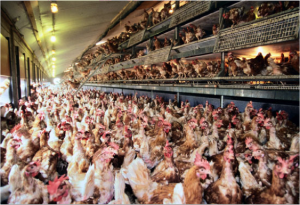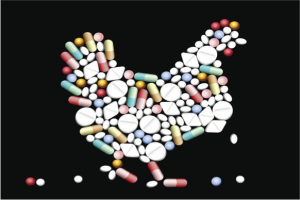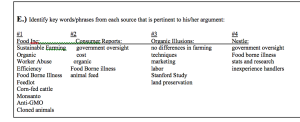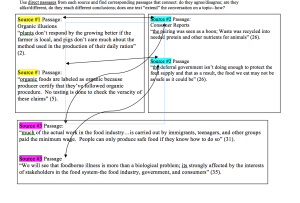Earlier this year 55 people were infected with e. coli in eleven different states from Chipotle. The causes for the outbreak are still unknown. The Chipotle on Marshall Street at Syracuse University was always packed every night with people trying to eat. Imagine if your teachers, yourself, or friends were one of the people who became extremely ill because of what they ate.
We eat food at least three times a day. People will go to the grocery store and just put things in the cart barely looking at the packaging. The public assumes that the food we eat is safe because the FDA and USDA regulate it knowing little about how the food industry works. The government is thought to have full control of the food industry but with the daunting task of inspecting millions of places with powerful companies seeking profit and efficiency, big business uses its power to control the food industry to maximize revenue. Big companies pressure the government into lessening regulations that are beneficial for them because they are resistant to food safety when it comes to maximizing profit. The public is in the dark when it comes to the food industry business and process of food making.
The government doesn’t have its leash tight enough on the food industry because they can’t tame the big businesses running the industry. It seems like the U.S. government is controlling the food industry, but actually big businesses are the ones in power because former CEO’s of their companies have roles in the government. The government is maintaining an illusion that the food industry is okay to the public when it really isn’t.
The problem in the food industry comes from all levels. The government, the producers, and the consumers all contribute and support the unruly food business. Nobody is willing to take the blame for problems that arise. Marion Nestle, a professor of Nutrition and Food Studies at NYU, in her book Safe Food: The Politics of Food Safety, specifically chapter one “Resisting Food Safety,” talks about how producers, processors, and the government are trying to place blame on each other when outbreaks of food borne illnesses occur. Nestle states how today’s food production encourages bacteria and viruses to spread with animals living in such close quarters. Not only are the living conditions poor, but the people raising the animals on the farm, or killing them in the slaughterhouse, are not educated enough to know how to protect themselves and the public from bacteria. Outbreaks are reported to the media but in the past decade, they have gotten nastier because bacteria like e. coli 0157:H7 have changed over time to be able to withstand extremely hot temperatures.
Nestle describes conditions where animals are held in large holding pens where they stay in extremely close contact among other animals until death where touch is only nee ded to spread pathogens. It is evident that there are people involved in every stage of food processing. Everyone must take responsibility for food safety but taking responsibility makes the businesses liable if something happens. That is why processors blame producers, the government blames processors and producers, and everybody blames the consumer. Each system of food processing (meaning producers and processors) doesn’t want to take the blame for anything because it can be devastating to business profits.
ded to spread pathogens. It is evident that there are people involved in every stage of food processing. Everyone must take responsibility for food safety but taking responsibility makes the businesses liable if something happens. That is why processors blame producers, the government blames processors and producers, and everybody blames the consumer. Each system of food processing (meaning producers and processors) doesn’t want to take the blame for anything because it can be devastating to business profits.
Earlier this year when the Chipotle outbreak occurred, its stock dropped 42 percent. Money is a reason why producers try to wash their hands clean of any responsibility. Because we eat food so often, it is very hard to determine where a food-borne illness was contracted. But consumers, even after hearing of an outbreak, will still keep eating at that place. Chipotle still has lines and yet had massive outbreaks all over the country. Even though there could be repercussions, the government needs to get a better hold of the food industry so problems will be addressed. In order for the changes to happen, the public needs to be informed.
One thing to be informed on is what Eric Schlossar, writer of Fast Food Nation, states in the documentary Food Inc.(2008). He says that the top four companies control 80% of the food industry. These companies have enough power to “bully” smaller companies, farmers, and to some extent, the government. The strength of companies like Tyson, Smithfield, and Monsanto pose great obstacles for the government when these businesses are trying to get regulations passed because they have people on their side working in prominent positions in the government.
In their article “You Are What They Eat,” Consumer Reports writes, “the need for slaughterhouses to find a cheap, safe way to dispose of waste gave rise to a marriage of convenience between renderers and food producers, and to the inclusion of animal by-products in animal feed” (26). Animal waste is recycled into feed, which is inhumane. Putting that into perspective, animals are fed their own waste, humans are eating the animals, and thus we are essentially eating animal waste as well. Plus, the effects of animal waste in humans are still unknown.

As you can see in this picture from 1950 to 2008, animals are fed drugs and their own waste to grow faster. The government is aware of what is given to animals and the toxins that humans are exposed to when waste is given to the animals we eat; however, they are not able to do much about it because of how many billions of dollars the drug companies make by selling their drugs to corporations and how little money it takes to recycle waste into food.
Nestle writes, “The FDA proposed to restrict the use of antibiotics in animal feed. Congress,however, overruled this idea under pressure from farm-state lawmakers, livestock producers, and the makers of the drugs” (Nestle 46). With the pressure place d on the government, there still lie regulation loopholes because billions of dollars are at stake. Food Inc. depicted how these businesses allow animals to live in wretched conditions where there is no sunlight, manure on the ground, and dead animals lying around. They feed the animals waste as “needed protein and other nutrients” and drugs in order to fatten them up cheaper in the shortest time period (26).
d on the government, there still lie regulation loopholes because billions of dollars are at stake. Food Inc. depicted how these businesses allow animals to live in wretched conditions where there is no sunlight, manure on the ground, and dead animals lying around. They feed the animals waste as “needed protein and other nutrients” and drugs in order to fatten them up cheaper in the shortest time period (26).
That quote, which is taken from Consumer Reports, is what businesses are using to justify feeding animal waste products, for the nutrients and protein. They are unwilling to sacrifice profit for food safety. When humans eat animals, food contains antibiotics in them; thus, humans can become immune to antibiotics that would normally help cure diseases. Nestle writes in another chapter, “Deregulating Dietary Supplements,” “its difficult to believe that this situation is in the best interest of the public (220).” The government is aware of the immunity that can occur and poses to be the top dog in the food industry and have the publics best interest, but can’t do anything about the antibiotics because of how few but powerful companies there are nowadays in this industry.
Schlossar, in Food Inc., says that there are only 13 slaughterhouses today. In the past, there were many companies, producers, and slaughterhouses distributing the power. Each company has so much leeway that even the government can’t control them.
Due to the lack of public knowledge about the food industry we are not able to make better decisions as consumers. This makes me question how much we really know about this business. There are plenty of articles and movies showing the sketchiness of the production of food but the public does not take the information seriously enough. Whether the public chooses to look the other way or just assume that what we eat is safe, humans need to be aware of the problems.
Many people would turn to organic food as the other option. Sometimes organic food is going to cost too much, but the public needs to be aware of what is going on so changes will occur. If the public decides to boycott one brand because of unruly practices, changes will happen. “Organic Illusions” by Blake Hurst creates doubt in the reader’s mind about organic vs. conventional farming. He writes, “organic foods are labeled as organic because producers certify that they’ve followed organic procedures. No testing is done to check the veracity of these claims” (Hurst 5). This makes the government’s role questionable in organic farming.
If the government is not checking whether or not organic food is actually organic then how is the public supposed to know if organic food is actually healthier and worth the extra money? The picture below is concerning because the FDA and USDA do not have enough manpower to regulate imports, warehouses, slaughterhouse, and farms. If the governmen t can’t even regulate conventional farming, how can they regulate organic farming as well? It’s an extremely important job but one that is not being done to the best extent. Overall, the government oversight of the food industry is a mess and needs to improve because there is too much to regulate for the system that we have now.
t can’t even regulate conventional farming, how can they regulate organic farming as well? It’s an extremely important job but one that is not being done to the best extent. Overall, the government oversight of the food industry is a mess and needs to improve because there is too much to regulate for the system that we have now.
If the government fails to step up to big businesses there will be more outbreaks, more deaths, and the businesses will keep profiting. Consumers will still be exposed to the harmful toxins that are put into animal feed that can lead to food-borne illness. More deaths will occur due to outbreaks and the public will still be ingesting antibiotics daily. People will become very concerned about the government and its role in protecting the people. If food is something that we need to survive, it needs to be well regulated to ensure safety and well being. It’s significant to end with a quote by Robert Kenner who stated it best in Food Inc. when he said, “The industry doesn’t want us to know the truth…if you knew the truth, you might not want to eat the food.”
UNIT 1 REFLECTION:
As I reflect on this unit I realize that trying to determine a writers project is pushing beyond the text of what the author is clearly stating but also trying to figure out what they are trying to accomplish by saying it. When reading an article find the main ideas, key words, and phrases to determine the project. A good question to ask yourself when trying to determine a project is, “What is the author trying to achieve/what issues are brought up?” After you figure what the author is trying to say, you can see how they relate examples to their ideas. My project for my blog article was to get the reader to understand that the government is not in full control of the food industry. There are companies using their power to influence the industry to benefit their company. I tried to use pictures that relate to my topics in the blog that would visually represent what I am trying to get across.
As I mentioned in class, the most helpful part of the Sort It Out workshop was section E where we had to find key words of phrases from each article. This allowed me to put the article’s key phrases side by side and see the differences and commonalities. This helped me be able to synthesize all the texts. After doing this I was able to determine my topic for my essay and base my claim around the key phrases I saw in all the articles.

Synthesis is the combination of ideas. It is important because when writing a blog that has to incorporate four different sources, you have to be able to incorporate all the materials. To do this, I had to try and find a common theme. Being able to synthesize the materials and find the common theme of government was how I came up with my topic for my blog. I thought this was the hardest part of this unit. I found it difficult to incorporate Organic Illusions by Hurst because it had a different viewpoint on the food industry.
A big accomplishment of mine from this unit was learning how to synthesize multiple texts. Since Food Inc., Marion Nestle’s article, and Consumer Reports had the same stance on the food industry, they were easy to bring into the blog and use as evidence supporting my claims. It took me a long time to figure out how to use Organic Illusions. Once I found a way to incorporate Hurst’s article, I felt really accomplished because I tried to use the article to make the reader question the government and its power.
My main idea was first going to incorporate profit. I wanted to talk about the money side of the food industry and how that was affecting production. After, I realized that money had to be a reason why companies behaved they way they did. Because of that, I changed my idea to focus more on how big businesses are using the government to lessen regulations in order to enhance their profits. I first made this as a lede, “The government is thought to have full control of the food industry but with the daunting task of inspecting millions of places with powerful companies seeking profit and efficiency, big business use their power to control the food industry to maximize profit.” After, I realized this is more of a main idea than a lede. It’s not creative enough to draw a reader in. It was convenient that my rough draft of my lede wound up being what I focus my paper on.
The Sort it Out workshop was the main organizational strategy I used. I was able to pull quotes from different passages that related to the same topic. That really helped me organize my thought because I had to write down the project and main ideas of each documentary or article. At first my structure of my blog was more like an essay. Two women at the writing center helped me break up my paragraphs and talk in a way that was more like a blog. For example, I had a over ten sentence paragraph and one lady helped me figure out where my topics changed a little which helped me determine where to split up my paragraphs.Nestle writes, “The FDA proposed to restrict the use of antibiotics in animal feed. Congress, however, overruled this idea under pressure from farm-state lawmakers, livestock producers, and the makers of the drugs” (Nestle 46). With the pressure placed on the government, there still lie regulation loopholes because billions of dollars are at stake. Food Inc. depicted how these businesses allow animals to live in wretched conditions where there is no sunlight, manure on the ground, and dead animals lying around. They feed the animals waste as “needed protein and other nutrients” and drugs in order to fatten them up cheaper in the shortest time period (26).
This exert from my blog I think is a good quote from where I connected Food Inc., Consumer Reports, and Nestle’s article in a concise manner. This evolved partially due to the last section of the Sort it Out workshop. The last part of the workshop allowed me to find quotes from different pieces that connected with each other. I changed one quote from the Sort It Out workshop because it didn’t fit well with the other quotes.
 My first draft of my lede wound up being the main idea of my blog. “The government is thought to have full control of the food industry but with the daunting task of inspecting millions of places with powerful companies seeking profit and efficiency, big business use their power to control the food industry to maximize profit.” That was my first draft. I thought about it more, and realized that it wasn’t going to draw a reader in. I tried to make my lead more creative by coming up with a dog and leash metaphor, “ The government doesn’t have its leash tight enough on the food industry because they can’t tame the big businesses running the industry. It seems like the U.S. government is controlling the food industry, but actually big businesses are the ones in power because former CEO’s of their companies have roles in the government. The government is maintaining an illusion that the food industry is okay to the public when it really isn’t.” I tried to say that the government is the dog owner that can’t control the dog. I thought it was creative and would draw a reader in. In my rough draft, it also didn’t state how businesses control the industry so I added another a few more words to state how the people in charge of regulations are on the same side as big businesses.
My first draft of my lede wound up being the main idea of my blog. “The government is thought to have full control of the food industry but with the daunting task of inspecting millions of places with powerful companies seeking profit and efficiency, big business use their power to control the food industry to maximize profit.” That was my first draft. I thought about it more, and realized that it wasn’t going to draw a reader in. I tried to make my lead more creative by coming up with a dog and leash metaphor, “ The government doesn’t have its leash tight enough on the food industry because they can’t tame the big businesses running the industry. It seems like the U.S. government is controlling the food industry, but actually big businesses are the ones in power because former CEO’s of their companies have roles in the government. The government is maintaining an illusion that the food industry is okay to the public when it really isn’t.” I tried to say that the government is the dog owner that can’t control the dog. I thought it was creative and would draw a reader in. In my rough draft, it also didn’t state how businesses control the industry so I added another a few more words to state how the people in charge of regulations are on the same side as big businesses.
I want to get better at determining the author’s projects. I believe once I can go deeper in finding the project, I’ll be able to synthesize more clearly and then create a better final draft. Also writing to the draft of a blog is something I want to work on so my paragraphs aren’t to long, my visuals go with the text, and I have proper and useful hyperlinks. I do like using the blog format because of the freedom it gives me to use visuals that I wouldn’t be able to do in an essay. I normally don’t read blogs and have been writing essays my entire life so I do think blogging is a genre that is challenging.
This unit made me realize that there are a lot of things going on behind closed curtain that the public is unaware of. The government seems to have an invisibility cloak over the food industry, hiding the public from the truth of what is really going on. Before we watched Food Inc. I went to the grocery store and bought chicken. That chicken is still in my freezer untouched. I am grossed out about how the animals are treated and the feed that they are given that I haven’t cooked the chicken.
This unit has made me interested in the food industry. I have already visited Marion Nestle’s blog and plan on reading her book Food Politics.